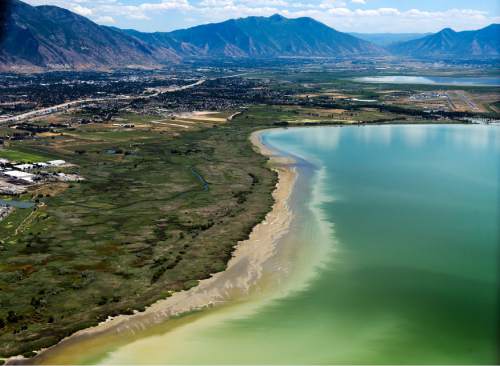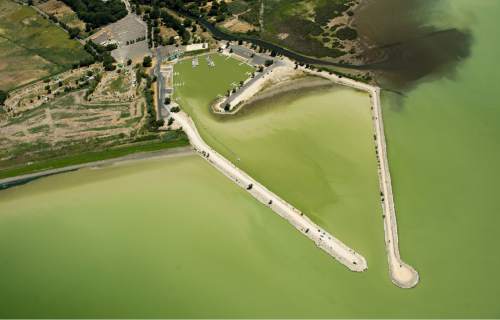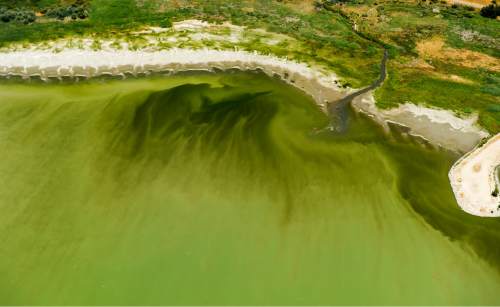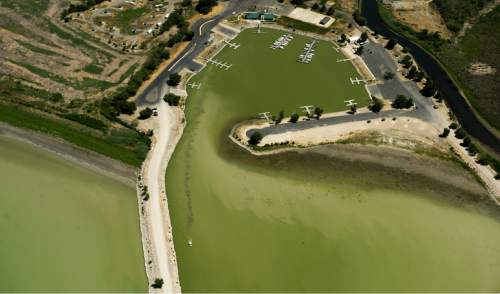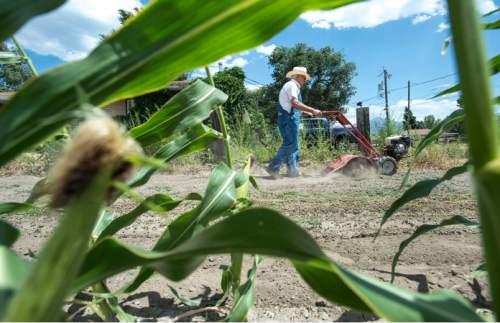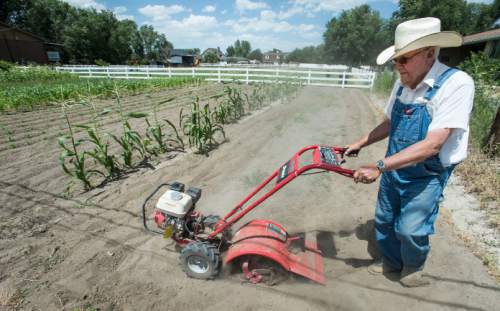This is an archived article that was published on sltrib.com in 2016, and information in the article may be outdated. It is provided only for personal research purposes and may not be reprinted.
Stephanie Cannon's tomatoes may go dry this week if algae from Utah Lake make their way into her irrigation canal.
"I wouldn't feel uncomfortable about watering my lawn with" irrigation water from the canal, said Cannon, a commercial tomato grower and president of the Upper Canal Irrigation Co. in Millcreek and Holladay, "but I don't want to put it on our tomatoes."
State water officials announced Sunday that algae from Utah Lake, where a toxic algal bloom was discovered last week, appear to have spread to the Jordan River and lower Little Cottonwood Creek. The bloom has not affected drinking water, but those who use secondary water from the Jordan River or Utah Lake have been warned that they should not irrigate until further tests determine whether the water in Salt Lake County canals is safe.
The Salt Lake County Health Department spent Monday morning posting warning signs at all major Jordan River access points between the county's southern boundary with Utah County and approximately 2100 South. Salt Lake City has posted signs at recreational access points between 2100 South and the county's northern line with Davis County.
In Utah County, the impact on farms and orchards has been minimal because most growers there draw water from wells or from Strawberry Reservoir, said Matt Hargreaves, a spokesman for the Utah Farm Bureau. But downriver — with several irrigation and canal companies opting to shut down their systems as a precaution — is a different story.
"We are very concerned for farmers that may be impacted by the water-quality problem. This is hitting farmers during the hottest and driest time of the year, when many of them are preparing produce for harvest. Any loss of water for their crops could have a devastating impact," Ron Gibson, president of the Utah Farm Bureau Federation, said in a statement. "We're equally concerned for any potential food-safety challenges."
The problem presents a conundrum for Larry Brown, a hobby farmer in Taylorsville who had planned on watering his pasture and garden Monday morning. Now, he said, he's unsure his irrigation water is safe for his two beef cows.
"I'm wondering what I'm going to do," he said. "Right now, I wish they would say that we could go ahead and water and that everything will be OK, but at this point, I would be very skeptical of putting water on my place."
Brown said he hasn't noticed any impact on his animals, because his cows haven't had direct access to irrigation water. But it has been more than a week since he last put water on his property, which also includes a quarter-acre vegetable garden. With his Taylorsville Irrigation Co. water line shut down, he's unsure when he'll have access to secondary water.
Not all users support their irrigation companies' decision to turn off water.
Luke Petersen, president of the Salt Lake County Farm Bureau, believes the board of the Welby Jacob Water Users Co. should have held off until more conclusive information was available.
"Nobody seems to know what the real threat is, but I can tell you what the threat of no water on my crop is with 100 percent certainty," Petersen said. "And maybe it is a real threat, but we'd like to have the water on until we know what the real threat is."
Petersen has about 100 acres of vegetable row crops on underground drip irrigation systems in Riverton. His plants can go about two days without water before being damaged, he said, and he doesn't have access to a backup water system.
"We're in real danger of not surviving as a farm," he warned, "if we can't water our crops."
Those who can tap culinary water as a backup should use caution if they decide to cross-connect their culinary and irrigation systems, said Linda Townes, public information manager for the Jordan Valley Water Conservancy District. Cross-connections require a back-flow device to prevent untreated secondary water from intermingling with drinking water. If the algae are already in the canal water, she said, an improper cross-connection could result in algae or toxins entering the drinking-water system.
"Then we would have an even bigger issue," Townes warned. "We just need people to know that they need to be very careful when they connect a secondary system to a culinary system."
Townes said those who are uncertain about the proper procedure for cross-connecting should stick to watering from a hose connected to their house's hose bib or tap.
The micro-organisms responsible for the Utah Lake bloom are capable of producing toxins that affect the liver and nervous system and can cause illness or death in humans as well as pets and livestock if ingested. Symptoms associated with exposure to toxic algae include skin rashes, headache and vomiting.
The state Department of Environmental Quality (DEQ), as well as state and area health departments, have advised residents to stay out of the affected waters, keep pets away and throw away any fish caught in those water bodies.
Those who are experiencing symptoms are advised to call Utah Poison Control at 1-800-222-1222.
Barbara Crouch, executive director of the Utah Poison Control Center, said her office has responded to 350 cases concerning people who were recreating on the lake, or concerning pets and livestock, since Wednesday.
At this point, she said, the center has yet to confirm whether any illnesses are linked to the algal bloom.
Riverton, South Jordan, West Jordan, and Herriman have closed their municipal secondary-water systems, according to DEQ. Herriman also has closed Blackridge Reservoir as a precaution. Secondary water in Daybreak has shut down, and Oquirrh Lake is off-limits to all recreational uses.
Kyle Bennett, a spokesman for Rio Tinto Kennecott, said the closure was precautionary and will remain in place until lab tests confirm that the lake is free of any of toxic algae. Oquirrh Lake and other secondary systems in Daybreak, which have also been turned off, obtain water from Utah Lake via the North Jordan Canal.
Bennett said Daybreak requested water-quality tests Monday but was unsure when results would be available because most local labs have been inundated with samples.




